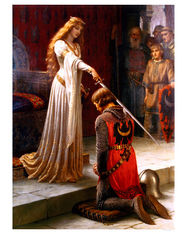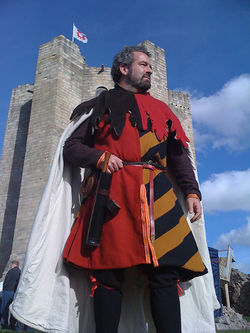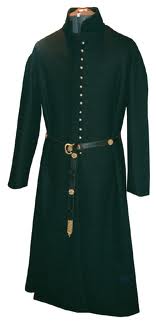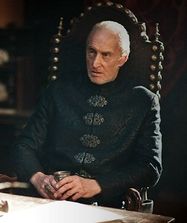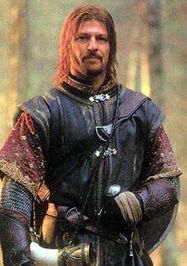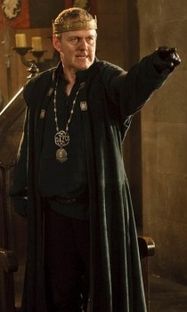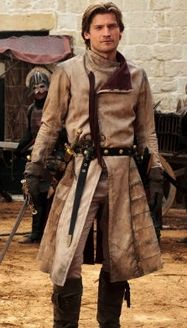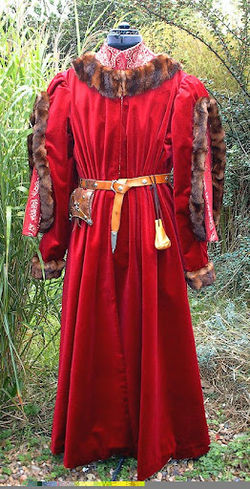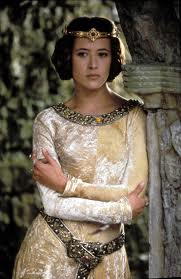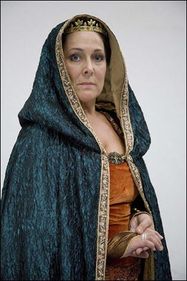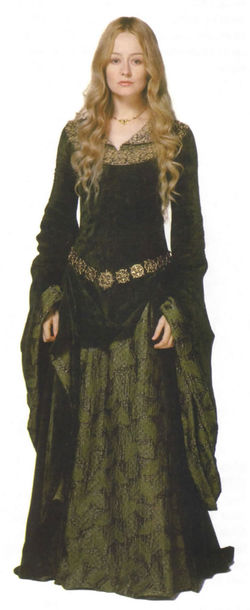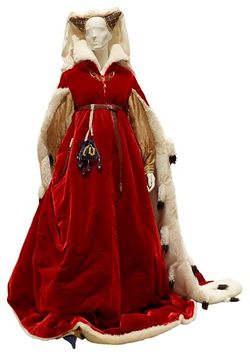Dawn costumes
| Line 18: | Line 18: | ||
===Similar nations=== | ===Similar nations=== | ||
<b>The Marches and Wintermark</b> | <b>The Marches and Wintermark</b> | ||
Parts of the Marches were once Dawnish, so it should come as no surprise that there are significant similarities in the costume. Both draw their inspiration from medieval north-western europe, so the bulk of the difference is in the materials used. The Marches tend towards a palette of natural colours in wools and linens, less lavish designs and simpler construction. The Dawnish, by contrast, favour bright, heraldic colours, contrasting trims and fabrics and more flowing garments using more material. Accessories play a big part in making an outfit look Dawnish - a colourful long belt, a jewelled dagger sheath, an ornate leather purse or a crown can all make relatively simple and understated costume look regal. | |||
Wintermark shares some basic similiarities in terms of garments and cut with Dawn, but it should be even less bright and less lavish than that Marches. Some very high status Steinr might wear something to the Senate that a Dawnish yeoman would wear in the fields - if you have a beautiful, simple tunic in drab colours, try accessorising it with a good belt, fine jewellery or a hood or mantle in a contrasting colour and suddenly it will look a lot more Dawnish. | |||
===Research=== | ===Research=== | ||
Revision as of 21:23, 1 August 2012
Look and Feel
Clothing in Dawn draws inspiration from the clothing of 12th-15th Century England and France, Pre-raphaelite artists such as Edmund Blair Leighton, Dante Gabriel Rosetti and John William Waterhouse, and fantasies such as Lord of the Rings, Merlin and Game of Thrones. On the battlefield, the Dawnish are a pageant of glittering armour, blazing heraldry and exquisite banners; at peace, they wear elegant and well cut tunics, houpellandes and surcotes. Women may also choose to wear gowns, usually with a long, smooth silhouette, full skirts and either tight sleeves to the wrist, or flowing trumpet sleeves that fall in folds from the elbow.
Fabrics
A guide to fabrics for kitmaking
Dawn is a country where you can really go wild with your fabrics and indulge yourself. For high status characters, rich wools, intensely coloured silks, fine linens and velvets are all a wonderful choice. Don't automatically assume that they're more expensive - like every fabric, there's a range, and if you shop carefully you can pick up some superb bargains. Ebay is always good. Try to stick to natural fabrics or natural/synethetic blends - pure synthetics are uncomfortable and wear badly, with very few exceptions.
Historically people tended to wear body linens - a soft white linen shift or shirt against their skin. This is a good idea not only because it's comfortable, but also because it protects your outer garments from sweat and stains. If you'd prefer not to use linen for reasons of expense or weight, a soft cotton muslin works beautifully for this. For outer garments, try fine wools, brocades, velvets and silks; for cloaks, cotton velvet and wool melton are ideal.
Similar nations
The Marches and Wintermark Parts of the Marches were once Dawnish, so it should come as no surprise that there are significant similarities in the costume. Both draw their inspiration from medieval north-western europe, so the bulk of the difference is in the materials used. The Marches tend towards a palette of natural colours in wools and linens, less lavish designs and simpler construction. The Dawnish, by contrast, favour bright, heraldic colours, contrasting trims and fabrics and more flowing garments using more material. Accessories play a big part in making an outfit look Dawnish - a colourful long belt, a jewelled dagger sheath, an ornate leather purse or a crown can all make relatively simple and understated costume look regal.
Wintermark shares some basic similiarities in terms of garments and cut with Dawn, but it should be even less bright and less lavish than that Marches. Some very high status Steinr might wear something to the Senate that a Dawnish yeoman would wear in the fields - if you have a beautiful, simple tunic in drab colours, try accessorising it with a good belt, fine jewellery or a hood or mantle in a contrasting colour and suddenly it will look a lot more Dawnish.
Research
- Historical/cultural inspiration (and how the nation differs/adheres to it), films, books, tv, google search terms
Google image search for burgundian gowns
In detail
Men
For male costume, there are a wealth of historical and fantasy looks for form the basics of your costume. The look should be dynamic, dramatic and exude power. As always, try to steer away from flimsy fabrics, drab colours and any look which obviously belongs in another nation - Dawnish clothes should demonstrate the wearer's exquisite taste, rank and nobility.
Bliault and Surcote
A man's bliault is a 12th century tunic, worn often with a sleeveless overtunic in heraldic or house colours. It's an easy look to achieve, either from off-the-peg reenactment kit or through making your own, and with a hood and cloak can look really splendid.
Here's How to make a Bliault and How to make a surcote
an inspiring hood: http://embroidery.racaire.at/?p=3306
a good hood article : http://www.virtue.to/articles/hoodlum.html
Robes, gowns and cotehardies
On men, a gown is a reasonably close fitting robe, usually buttoning down the front, with long close fitting sleeves to the wrist. It was worn by clerics and academics historically, and persists to this day as the cassock and in the clothes of choirsters and some very traditional public school uniforms.
It's a very adaptable look - a fantasy treatment could take the basic silhouette and standing collar, and shorten the overall length, either with full length or half length sleeves, as worn by Boromir, Uther Pendragon and Jamie Lannister for a "warrior's coat". It looks good worn open over chainmail. A close-fitting variant of this is the cotehardie which usually has lots of closely spaced buttons down the front and the sleeves - try googling "cotehardie". It can be a tough look to pull off, but well worth it!
Patterns:
- Butterick 6844
- Simplicity 2235
- Simplicity 4697 (unfortunately out of print but you might get it on ebay)
- Simplicity 2089(this one would need a little adapting - closed sleeves rather than open, but would do a nice over-robe like Boromir's if you make a sleevless version)
- Reconstructing history man's cotehardie
The Houpellande
This is a loose robe-like garment which can be knee or ankle length, with a variety of sleeves and necklines, which can be worn belted or loose. It's different from the style above as the waist isn't fitted - a great choice to show off lots and lots of thick and heavy fabric. It has the major advantage that you can just throw it over anything at all underneath and not worry about your under-kit being revealed. However, it really needs to be in fairly heavy cloth to look right, ideally wool, and can get a bit stuffy in hot weather. Team it with a chaperon hat for a really resplendent look!
- Period Patterns 26
- How to draft a Houppelande pattern
- Houppelande drafting
- More drafting instructions
- Butterick 5626 (you could make a really fun houpellande out of this!)
Women
There is absolutely nothing to stop women wearing any of the styles above - the Empire doesn't require long skirts to be worn for modesty any more than it requires your hair to be covered. However, there's fun to be had in resplendent gowns - and you can be as historically inspired as you like without needing to choose an "authentic" but unflattering style.
Fantasy and "historically inspired" gowns
The blue dressmade of two contrasting fabrics - a gold brocade and a blue fabric which you could replicate with a richly coloured fine wool, silk or linen. Use Simplicity Pattern 4940 (http://www.simplicity.com/p-2201-costumes.aspx) view C (without the corselet/vest), and cut your centre front piece and lower sleeves out of the brocade to contrast with the blue. The pattern will give you a slightly thicker band of brocade at the neck, which you could easily trim down, and will sit on your shoulders rather than off (which is much more practical for active wearing). I'd suggest replacing the zip down the back with lacing - it's just as easy and lacing never jams or breaks in a field.
Add some dangly earrings and a crown and you're set.
You could use Butterick 4377 for the cream dress from Braveheart and the blue cloak (http://butterick.mccall.com/b4377-products-5145.php?page_id=385) To replicate the soft, lush look of the dress, you could choose a soft silk velvet or, if you chose carefully, a synthetic stretch velvet, but please choose a good one with a nice thick pile! If you use a good heavy stretch velvet, you could omit the lacing down the back and just wear it as a pullover dress. For a different look you could use silk, lightweight wool or linen - just choose a lush, rich colour. For the neckline, you could cut a piece of brocade to match the curve of your neckline and carefully sew it on by hand, or you could get some fancy trim or ribbon. For the belt, try looking for a charity shop chain link belt, or make one out of a strip of silk and an old buckle, or use some fancy trim. eBay is a great source of trim - for some really splendid beaded trim at very reasonable prices I use this eBay shop - http://stores.ebay.co.uk/Heritage-Trading/Sewing-Trims-/_i.html?_fsub=2&_sid=47896792&_trksid=p4634.c0.m322 . About 2m would do a great jewelled belt, they also sell shaped pieces designed to go on the necklines of dresses. For the cloak trim, the same ebay shop is good, or you could try searching for damask trim or brocade trim.
Lord of the Rings is a great source of inspiration for women's dresses. Simplicity 4940 is a good place to start, as is McCall's 4491. http://www.alleycatscratch.com/lotr breaks down every costume in the movie, and is a fantastic resource for choosing the right pattern, fabrics, trim and accessories - even if you don't want to exactly duplicate a film costume, it's full of useful information. A word of warning - while many of Arwen's gowns are ideal for Dawn, avoid the more oriental looking ones as they are probably better suited to Urizen. Eowyn's White Gown, Coronation Gown, Green Gown and Victory Gown are all ideal, but many of the others belong in Wintermark or the Marches.
Historical gowns
The Houpellande
Houpellandes are great on women, too. It's not the easiest look in the book, but it looks very striking. The one in the picture is velvet lined in fur, which gives it tremendous bulk and body - an alternative would be to line most of it in thick blanket wool, saving your fur or fake fur for the edges.
- Period Patterns 26
- How to draft a Houppelande pattern
- Houppelande drafting
- More drafting instructions
Specifics
The Bliaut is a similar dress, the main difference between this and the kirtle is the wide flowing sleeves and the very tight fit, achieved through lacing on both sides of the dress.
Bliaut
The other style of dress worn in Dawn is an unfitted robe, gathered in at the waist by a belt. This started life as the Houppelande, a large, robe like garment worn by men and women. Women belted this high under the bust and, over time, the burgundian gown evolved from this, with a similar shape but a deep v-neck. These dresses are far less revealing as the fit is looser than the kirtle and similar dresses, and the belt helps to define the waist. The large amount of fabric used in this style of dress makes it better for wealthier characters.
Houppelande
- Period Patterns 26
- How to draft a Houppelande pattern
- Houppelande drafting
- More drafting instructions
Burgundian gowns
Something that can be worn over the tunic or doublet, or on its own is the men's Houppelande, also called a Gown. This is a robe like garment that is cut very wide, and can be belted at the waist or worn loose. There are a lot of variations of the gown, as it was popular for most of the medieval period and changed throughout the era. The sleeves can be very large in the middle, but narrow at the shoulder and cuff (called bagged sleeves), narrow all the way down or wide and flowing. For higher status gowns, the sleeves can be split from cuff to shoulder and allowed to hang freely, leaving the arms free. The length varies from on the hip, to floor length.
Houppelande
- Period Patterns 26
- Simplicity 5925
- Reconstructing History 005
- Costuming high, middle and low status character
- Men/Women/children in each category?
- What you can achieve at different price brackets? (thinking of doing something along the lines of the Odyssey £30 kit challenge maybe Daisy and Jude!)
Hats and outerwear
http://www.kats-hats.co.uk/index.shtml http://www.virtue.to/articles/reticulated.html
Jewellery
Armour
Weapons
Heraldry
Bibliography
- Both an online “would you like to know more!” and a guide to the amazing books you can get on amazon.
Nation specific garment
- Possibly – if we can think of something suitable for each nation!
